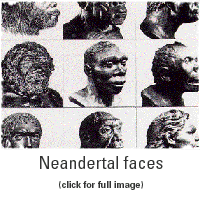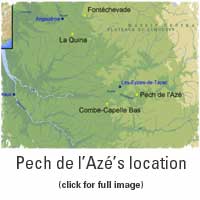• What is the Middle Paleolithic?
• What is a Neandertal?
• What kinds of things do you find at a Neandertal site?
• Where is Pech IV and how old is it?
• Why is Pech IV significant?
• How do archaeologists dig?
• Hear the dig crew: What did you find surprising about working at Pech IV?
• What kinds of stone tools were found at Pech IV?
• How do archaeologists know what stone tools were used for?
• What do archaeologists do with all the stuff they dig up?
• How do archaeologists figure out what happened at a site?
• Hear the researchers: what misconceptions are there about archaeology?
• Hear the dig crew: what advice would you give to someone trying to join a dig?
• Meet the dig crew: where are you from?
• What is the Middle Paleolithic?
The Middle Paleolithic has been traditionally defined as a flake tool industry, which was meant to differentiate it from earlier Acheulian industries (with bifaces, or handaxes) and later Upper Paleolithic industries (characterized by blades and blade tools). Typologically, that is in terms of the retouched lithics, Middle Paleolithic assemblages are often composed of two major classes of tools: scrapers and notches/denticulates. Scrapers are tools that exhibit a continuous and generally smooth retouching along one or more (usually lateral) edges. Notches are flakes that have a relatively deep concavity along an edge produced either by a single blow or a series of fine retouch removals. Denticulates are types which have two or more adjacent notches. Recent work has radically altered notions regarding the chronology of the Middle Paleolithic. Traditionally, the Mousterian was thought to date from only the early part of the last glacial, or about 80,000 BP, with some occurrences of earlier last Interglacial industries termed "Premousterian." The revised chronology, based on correlations of marine and terrestrial sequences, now suggests that the date of the onset of the last glacial period, or Würm (oxygen-isotope stage 5d) is 115,000 BP, extending the duration of the Würmian industries by as much as fifty percent. Moreover, assemblages absolutely characteristic of the Middle Paleolithic are now known to date to oxygen-isotope stage 8, or about 250,000 BP.
Back to top
• What is a Neandertal?
Neandertals are an extinct group of hominids who lived in Western Eurasia (Europe and the Middle East) between about 130,000 and 30,000 years ago. Their relationship to anatomically modern humans (Homo sapiens sapiens) is the subject of much on-going debate. Some researchers believe that Neandertals were a separate species (Homo neanderthalensis), who went extinct without contributing to the gene pool of modern humans. Other researchers think that Neandertals are part of modern human ancestry, so that the differences between them and us are at the subspecies level (Homo sapiens neanderthalensis). There is also much debate about whether Neandertals exhibited behavioral strategies that we would identify as modern.

Back to top
• What kinds of things do you find at a Neandertal site?
Sites where Neandertals lived typically contain stone artifacts and animal bones. More rarely, we find evidence of hearths (fires for cooking or warmth) or organic materials such as wood. Exceptional site preservation conditions at the site of Lehringen in Germany, for example, yielded what appears to be a wooden spear. Some archaeological sites have also produced skeletons (usually incomplete) of Neandertals. There is debate over whether these represent burials in the sense of modern ritual behavior or are simply a way to dispose of a bad-smelling corpse. Finally, at the Grotte du Renne in northern France, there is evidence that some Neandertals made beads and bone tools.
Back to top
• Where is Pech IV and how old is it?
Pech de l'Azé IV is an archaeological site in the Périgord region of southern France. It dates to the time of the Neandertals and contains occupational debris from many millennia of Neandertal intermittent use of the cave. This sequence of occupation begins perhaps about 80,000 to 90,000 years ago, and ends about 35,000 years ago.

Back to top
• Why is Pech IV significant?
Pech de l'Azé IV is significant for several reasons. First, it is an important Neandertal site with a long sequence of occupations spanning a period of about 45,000 to 55,000 years during the last Ice Age (Pleistocene epoch). Second, the basal (bottom) layers at the site contain numerous hearths, which are not commonly found in European archaeological sites of this time period. Third, one of the lithic assemblages, the Asinipodian, is an unusual combination of very small and very large flakes and cores. This type of Neandertal assemblage is known only from Pech IV. (Read about this assemblage in the Story section, Chapter 7.) Finally, isolated Neandertal teeth have also been found at the site.
Back to top
• Hear the dig crew: What did you find surprising about working at Pech IV?
• What kinds of stone tools were found at Pech IV?
Thousands of stone tools have been recovered from excavations at Pech IV. They include many formal tools types such as scrapers, notches, denticulates, and handaxes, as well as the cores and flakes, such as Levallois flakes, that were not made into formal tool types.
Back to top
• How do archaeologists know what stone tools were used for?
Archaeologists have made many attempts to figure out the uses of stone tools. We know from experimental archaeology that stone tools can be used to scrape, cut, saw, and chop. In the time of the Neandertals, stone tools seem to be used mainly for meat and hide processing, as well as for woodworking (perhaps to make spear shafts). Most individual archaeological stone tools, however, appear to have been used for a variety of tasks, and therefore there is no one-to-one match between a task and a specific shape of a stone tool. A scraper, for example, might be used to scrape a hide, but might later be used to cut meat.
Back to top
• What do archaeologists do with all the stuff they dig up?
Detailed spatial coordinates for all cultural materials recovered from an archaeological site, as well as specialized samples such as sediment and materials for dating, are recorded in a computer database. The cultural materials, such as stone tools and animal bones, are washed, labeled, analyzed, and stored for future research work. To see this process in action, watch a brief video on the "Life of an Artifact."
Back to top
• How do archaeologists figure out what happened at a site?
The context of archaeological materials at a site is a crucial key to figuring out what happened at a site. Recording the spatial coordinates of stone tools, animal bones, and features such as hearths, provides some of the context. Other lines of evidence come from geological study of the sediments, detailed analyses of the stone tools and animal bones, and the application of dating techniques such as radiocarbon (14 C), thermoluminescence (TL), and electron spin resonance (ESR). (Read about dating techniques in the How section, Chapter 2.) In combination, the results of these specialized studies and the spatial information help show which materials are associated and they yield data about the types of animals used for food, the types of stone tools made and used at the site, and the day-to-day activities of the site’s inhabitants.
Back to top
• Hear the researchers: what misconceptions are there about archaeology?
• Hear the dig crew: what advice would you give to someone trying to join a dig?
• Meet the dig crew: where are you from?







